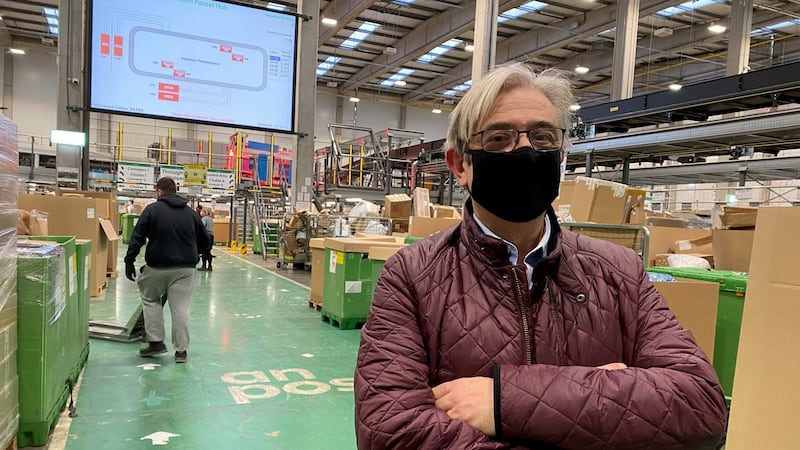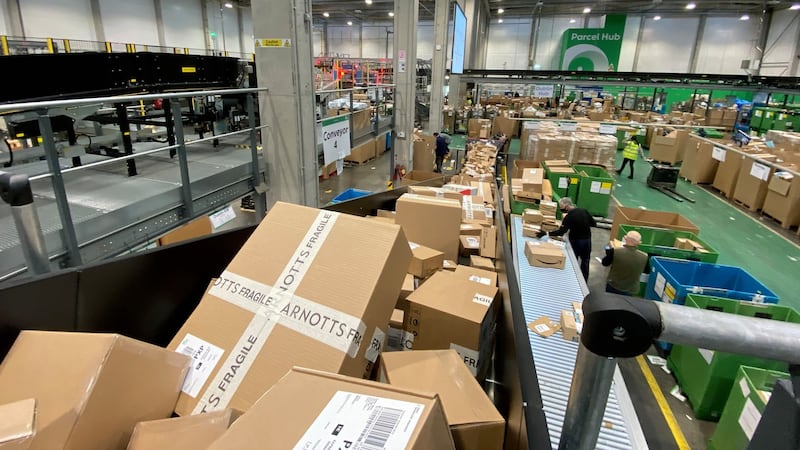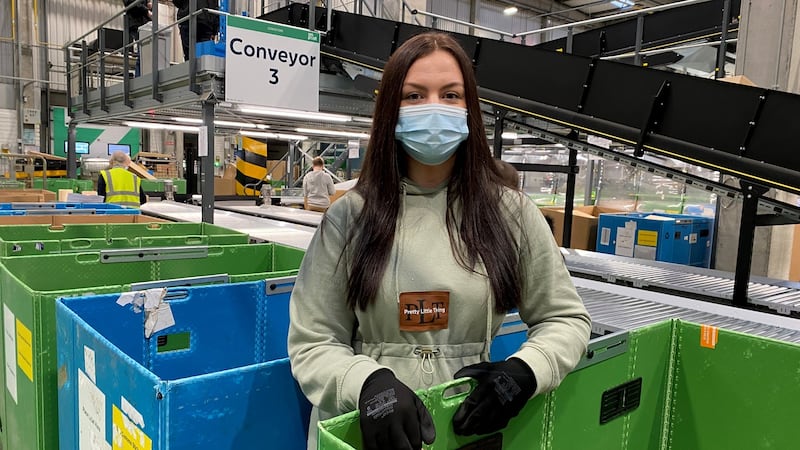Someone in Lucan is getting an electric scooter for Christmas. It arrived by ship from Poland early on Thursday morning and found its way to An Post's mail centre campus – two large warehouses near Ballymount, west Dublin, where 3.3 million packages are now being sorted and sent every week.
Over the next 24 hours, the scooter in its packaging will be unloaded, wind its way along a complex carousel system and be placed inside another truck and brought to the Parkwest staging centre before finally arriving at a front-door destination some time on Friday morning.
It is the journey of just one parcel. But take your eye off it for a split second and it becomes lost in a sea of brown and white cardboard, countless thousands of tonnes of which are trundling through the postal system in the build-up to a Christmas that, due to the pandemic, is more reliant on postal delivery than ever before.
On a steel gantry overlooking the sprawling machinery (An Post has invested €30 million in its "ecommerce campus"), floor operations manager Maurice Ebbs (51) is as enthusiastic about the process as the children will be about the presents on Christmas morning.

“There has been unbelievable change,” he says. “The volumes in the last couple of years; it’s probably more than trebled.”
He knows all about change. As a 16-year-old junior postman in the mid-1980s, he started out delivering telegrams from the back of a motorbike.
“In the parcel business we have gone from [mainly] delivering furniture to much smaller parcels.”
In many ways that encapsulates where An Post is today – with letters ever dwindling, growing volumes of smaller consumer packages, ordered online, represent the future. At the mail centre, they funnel by at high speed around a spaghetti junction of conveyor belts, scanners and bins that fill much of the 45,000sq ft of noisy warehouse space.
As Ebbs mentions, this year’s weekly seasonal throughput is more than triple the previous record of one million packages set last year.
A quick glimpse among the huge pallets and boxes reveals Christmas gifts and deliveries from the likes of Zara, Arnotts, Hampers & Co, and HP Nutrition. Amazon arrows are omnipresent. A vast array of random consumer goods – everything from guitars and bags of barbecue coals to surfboards and trampolines – fill two kilometres worth of trucks, back to back, on a daily basis.
Things “start” at 7am but never really stop – there is just a two-hour window for machine maintenance.
Full trucks
Ross Tredt (36), a process area manager who oversees the trucks, says there has been "no let-up" through the pandemic. The trucks he oversees reverse up and pull away every 20-30 minutes, each holding 2,000-5,000 packages. They never stop.
Does he dream about parcels? “Nightmares! It’s just been non-stop.”
But the pandemic has been a tale of two postal systems for chief executive David McRedmond.
“The first story is [that] the pandemic has hit really hard financially for An Post because letter volumes dropped dramatically, and letters are much easier to handle and they are much more profitable,” he says. Although Christmas stamp sales are more than healthy, An Post is facing a €50 million financial hit in 2020 due to lost letter business and various increased costs associated with the pandemic.
“The really good news, though, is strategically it’s moved us forward about two or three years. We were going to go through this gradual decline in letters and gradual increase in parcels; instead you have just seen a jump – like that. So we are now really operating where we would have expected to operate in, say, 2023.”

All around him the shiny new machines are purring and wheezing to keep up with this abrupt fast-forward. From the trucks, parcels are fed on to a series of connecting conveyor belts, slowed and evenly spaced by human hands before being funnelled through a scanner, which records the barcodes, and then tipped into destination-specific bins.
These in turn are loaded on to yet more trucks and dispatched to 113 delivery depots around the country. Much of the process is automated, a far cry from the human handling of 10 years ago that would, says director of international mail Cyril McGrane, have potentially added another 24 hours to delivery times.
Today they process up to 12,000 parcels an hour – compared with 1,000 in the manual days – which on Wednesday alone added up to a total of 167,000.
“It’s mind-blowing scale change,” says McGrane, who predicts the surge in activity will last well into the January sales.
Fish guts
It is not all pristine Amazon packages and square boxes. Paula Robinson and Donna Nolan work in the international section, unloading the one or two trucks that arrive from the airport at 6am each morning.
They work closely with customs officers and have encountered everything from second-hand clothes to “bush meat”, fish guts and any manner of rotten food products that “ooze out” and destroy neighbouring parcels.
“Some days we have to go home and fumigate ourselves,” Paula laughs, although like everyone else they describe their job with a certain affection. Even bizarre Christmas gifts have a home to reach.

Over the next year An Post plans to adapt its systems for ever more efficiency, moving the emphasis further away from letters. But McRedmond is keen to bring the public along, and savvy PR moves during the pandemic have helped (the idea of distributing five million free postcards last March was based on similar St Patrick’s Day versions once gifted by Senator Feargal Quinn).
“We became very motivated by really being a front line in the pandemic, and in relation to how people think about An Post, I think it has changed it,” he says.
But will the old romanticism of the village postman delivering letters be pushed aside by a tide of ruthless automated efficiency? “I think we want to achieve both,” McRedmond replies.
“It’s a really important part of what An Post is, that human connection. So we’ll always have postmen and postwomen, we will always have them.
“But they’ll now be in an electric van; they’ll now be calling at different times of the day; they’ll now be on slightly different routes. So, yes, there will be changes but for the consumer, for the person living at home, they’ll still know their postman or postwoman. That’s really important but the whole system behind them will be completely different.”
CHRISTMAS POST: BY NUMBERS
3.3 million The number of packages An Post will process each week in the run-up to Christmas.
1 million The previous record set last year.
2km The equivalent length of trucks that use the central mail centre every day during December.
€30 million The recent investment in technology at its ecommerce campus mail centre in Dublin.
8% The annual rate of decline in traditional letters.
1,000 The number of additional staff brought into An Post's central campus to help sort Christmas packages.












